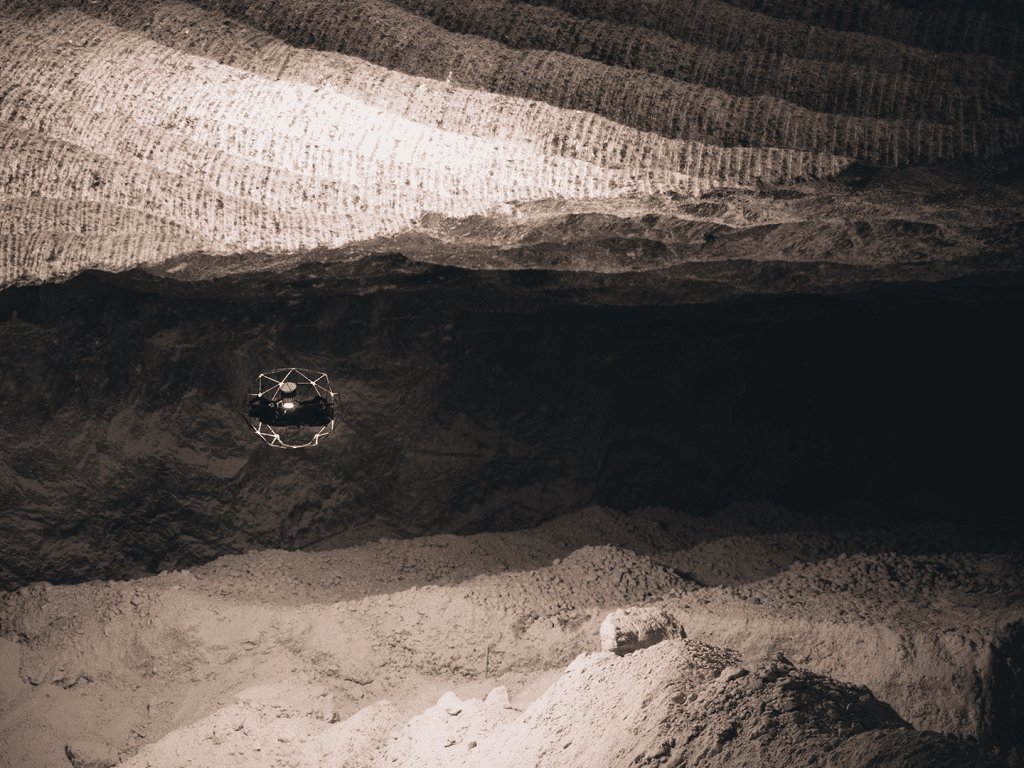When one thinks about drone technology, it is easy to picture a machine flying overhead collecting data that helps exploration and stockpile management. However, the use of drones extends beyond that, and now they are being deployed in underground operations. One such drone is the Elios 3, which has been developed by the Swiss company Flyability. GERARD PETER finds out more from ELOISE MCMINN MITCHELL, Flyability’s Vertical Marketing Manager.
Underground operations expose the human workforce to a number of risks. The use of technology such as drones can help mitigate these risks by keeping people out of harm’s way. “Our company’s vision is to ensure that humans don’t have to do dangerous jobs any more. We believe that drones can be sent into dangerous areas inside underground mines instead, such as areas where there are challenging and confined spaces. It is for this reason that we developed the Elios,” states McMinn Mitchell.
Flyability first introduced the Elios in 2016. The latest version, the Elios 3, was introduced in 2022. This specialised drone is surrounded by a protective cage and comes equipped with a 4K camera and a 16 000 lumens lighting rig. The company has also developed four payloads that can be used with the drone. These are a LiDAR scanner, a radiation dosimeter, an ultrasonic thickness payload and a low-explosive gas level sensor.
All of these ensure that the drone can operate in challenging underground conditions. McMinn Mitchell explains: “For example, once the drone is beyond your visual line of sight, it’s very challenging to understand what’s going on. The Elios 3’s camera gives you a full field of view. It also has different light settings enabling one to see in different environments.
ALSO READ:
Drone technology: A solution for maximum impact
“However, sometimes there is too much dust, and this is when the LiDAR payload is deployed. While the drone is flying, the LiDAR payload is engaging in Simultaneous Localisation and Mapping (SLAM). Not only is it scanning its surroundings, but it creates a 3D model as it flies. This allows the operator to navigate the surroundings when the drone is not in sight from up to 100 m away.”
The Elios 3 also has automation features such as return to signal. When it detects that it has no signal, it can return to the operator by flying back on the same flight path. Another feature is Smart Return To Home (RTH). This feature allows the drone to analyse its surroundings, make decisions and take the shortest route back to the operator at the end of an inspection or to change batteries.
Working in confined spaces means that there is a likelihood that a drone could crash into a cave wall. In this event, the flexible cage reduces the impact. The cage comprises a series of connecting hexagonal shapes. If one piece gets damaged, you can simply replace it with a new one. Also, the propellers automatically reverse and help the drone to restabilise and continue on its path.
While there are other technologies, such as robots, being used in underground mining, McMinn Mitchell states that there are several advantages to using a drone. “Because it is airborne, a drone can move over rocky terrain quickly. It is also able to get access to particularly complex environments and move with a lot more freedom. Furthermore, it’s not just used for scanning caves. It can also be used for measuring stockpiles and doing volume calculations. In the past, you would have had to use scanners to do this. Now, with the Elios 3, you can collect data from an entire space rather than having someone walk around or climb the stockpiles.

“The drone can also give you centimetreaccurate data from the LiDAR scans. If you combine the 3D models with the camera view, it provides multiple layers of data collection. In addition, the Elios 3 is easy to fly. It’s very intuitive, and you can have it deployed within a couple of minutes of arriving on site, and it can be easily integrated into existing workflows.”
Already, the Elios 3 is enhancing safety and productivity in African mines. A case in point is Palabora copper mine in South Africa. “The mine is using the drone on a near-daily basis. It is used to scan voids after controlled explosions as well as inspect support pillars. It is also used to examine shotcrete treatments by ensuring that the treatments are applied correctly and evenly throughout the entire area,” explains McMinn Mitchell. She adds that there has been significant interest in the Elios 3 from African mining operations.
“Mining is one of the oldest industries and it would be easy for such an industry to be set in its ways. However, we’re not seeing that at all – especially in the African mining market. There is a massive interest in using drone technology and making operations more productive, easier and safer for everyone,” she concludes.


